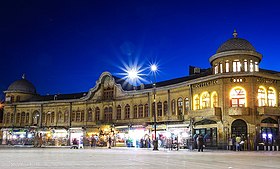This article needs additional citations for verification. (December 2023) |
Hamedan
همدان | |
|---|---|
City | |
|
Central square, Nazari Museum garden, Monument, Abbasabad Spa, Quranic and International Convention Center, Tomb of Avicenna | |
| Coordinates: 34°47′54″N 48°30′53″E / 34.79833°N 48.51472°E[1] | |
| Country | Iran |
| Province | Hamedan |
| County | Hamedan |
| District | Central |
| Government | |
| • Mayor | Seyed Masoud Hosseini [2] |
| Elevation | 1,850 m (6,069 ft) |
| Population (2016)[3] | |
| • Total | 554,406 |
| • Rank | 13th in Iran |
| Time zone | UTC+3:30 (IRST) |
| Website | www |
Hamedan (/ˌhæməˈdæn/ HAM-ə-DAN;[4] Persian: همدان, pronounced [hæmeˈdɒːn])[a] is a city in western Iran. It is located in the Central District of Hamedan County in Hamedan province, serving as the capital of the province, county, and district.[5] As of the 2016 Iranian census, it had a population of 554,406 people in 174,731 households.
Hamedan is believed to be among the oldest Iranian cities. It was referred to in classical sources as Ecbatana (Old Persian Hamgmatāna). It is possible that it was occupied by the Assyrians in 1100 BCE; the Ancient Greek historian, Herodotus, states that it was the capital of the Medes, around 700 BCE.
Hamedan is situated in a green mountainous area in the foothills of the 3,574-meter Alvand Mountain, in midwestern Iran. The city is 1,850 meters above sea level. It is located approximately 360 kilometres (220 miles) southwest of Tehran.
The old city and its historic sites attract tourists during the summer. The major sights of this city are the Ganj Nameh inscription, the Avicenna monument and the Baba Taher monument. The main language in the city is Persian.[6][7][8]
- ^ OpenStreetMap contributors (17 October 2023). "Hamedan, Hamedan County" (Map). OpenStreetMap (in Persian). Retrieved 17 October 2023.
- ^ "سیدمسعود حسینی شهردار همدان شد". Mehr News (in Persian). 4 September 2021. Retrieved 9 April 2024.
- ^ Cite error: The named reference
2016 censuswas invoked but never defined (see the help page). - ^ "Hamedan". Merriam-Webster.com Dictionary. Merriam-Webster.
- ^ Habibi, Hassan (21 June 1369). "Approval of the organization and chain of citizenship of the elements and units of the country's divisions of Hamedan province, centered in Hamedan city". Lamtakam (in Persian). Ministry of Interior, Political Defense Commission of the Government Board. Archived from the original on 11 February 2024. Retrieved 11 February 2024.
- ^ "Introduction". www.hamedan.rmto.ir. Archived from the original on 22 December 2015. Retrieved 20 December 2015.
- ^ Mohammad Jalal Abbasi-Shavazi, Peter McDonald, Meimanat Hosseini-Chavoshi, "The Fertility Transition in Iran: Revolution and Reproduction", Springer, 2009. pp 100-101: "The first category is 'Central' where the majority of people are Persian speaking ethnic Fars (provinces of Fars, Hamedan, Isfahan, Markazi, Qazvin, Qom, Semnan, Yazd and Tehran..."
- ^ (Parviz Aḏkāʾi and EIr, HAMEDĀN i. GEOGRAPHY in Encyclopædia Iranica:"Languages spoken. Hamedān has been a crossroads of civilizations for millennia and a mosaic of cultures and dialects live there side by side. The main language spoken, especially in the provincial capital and its surroundings, is Persian, which is also the lingua franca in other regions. In the northern parts of the province, however, the language mostly spoken is Azeri Turkish, while in the northwest and west, near the provinces of Kurdistan and Kermānšāhān, people mostly speak Kurdish, while in some other cities such as Malāyer, Nehāvand, and Sāmen most people speak Lori and Lak (Faraji, p. 1296)."
Cite error: There are <ref group=lower-alpha> tags or {{efn}} templates on this page, but the references will not show without a {{reflist|group=lower-alpha}} template or {{notelist}} template (see the help page).






